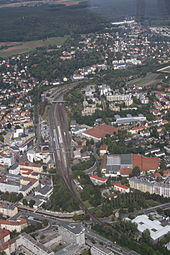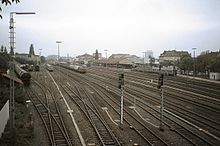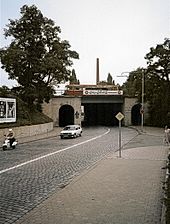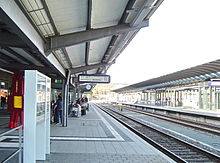Bayreuth Central Station
| Bayreuth Central Station | |
|---|---|
|
Entrance building, street side
|
|
| Data | |
| Operating point type | railway station |
| Location in the network | Separation station |
| Design | Through station |
| abbreviation | NBY |
| IBNR | 8000028 |
| opening | November 18, 1853 |
| Website URL | stationsdatenbank.bayern-takt.de |
| Profile on Bahnhof.de | Bayreuth_Hbf |
| location | |
| City / municipality | Bayreuth |
| country | Bavaria |
| Country | Germany |
| Coordinates | 49 ° 56 '59 " N , 11 ° 34' 48" E |
| Height ( SO ) | 337 m above sea level NN |
| Railway lines | |
|
|
| Railway stations in Bavaria | |
Bayreuth Hbf is the starting or ending point of four single-track, non-electrified railway lines, three of which are main lines . The station belongs to station category 3 and to the network area of the Greater Nuremberg Transport Association . It is the largest train station in Bayreuth as well as the most important of the four - of the former ten - existing in today's urban area .
History until 1945
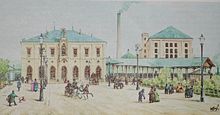
The routes
Construction of the leased railway and the first station building
On November 28, 1853, the city was connected to the Bavarian railway network with the opening of the Neuenmarkt railway line. At that time this only consisted of the railway line from Kempten (Allgäu) via Nuremberg and Bamberg to Hof , the so-called Ludwig-Süd-Nord-Bahn , with a southern branch to Munich and a northern branch to Schweinfurt .
After several requests from the city magistrate (first on March 18, 1836) to run this route via Bayreuth had been refused, the city asked on July 30, 1844 for the first time permission for preparatory work for the connection by a branch line. On January 31, 1845, the application for permission to found a stock corporation for its construction followed. These efforts were also unsuccessful; the matter was "shelved" in the state capital of Munich on October 18, 1845.
A next request in 1850, however, was crowned with success. A royal resolution of July 25th of that year read: "We permit that, in the appropriate cases, applications for leasing the operation of private railways for the account of the state may be brought to Us by the relevant ministries of state." The subsequent between the municipality Bayreuth and the "Royal Bavarian State Government" signed the contract included the financing and construction of the railway including all buildings through the city. The operation was leased to the state government for a period of 50 years, with a "lease schillings" of 55,000 guilders (according to other information 80,000 guilders) to be paid at the end of each budget year. The government undertook to operate the railway and reserved a purchase right against payment of the construction capital. On this basis, the first Bavarian leased railway was built from October 1852 and opened on November 28, 1853. The branch line was operated by the Royal Bavarian State Railways (K.Bay.Sts.B.).
While the route, which runs largely through the Trebgast Valley, was built quickly, the final point in Bayreuth was discussed first. Citizens and merchants favored a central train station in the valley of the Red Main on Schwarzen Allee (today's Kanalstrasse). A ministerial commission sent to Bayreuth on May 27, 1853, however, spoke out in favor of the ultimately chosen location at the then Brandenburg Gate. A train station on Schwarzen Allee would have made it necessary to bridge the river and the area was at risk of flooding. The available space would be too small and the access roads would be “extremely limited”. Compared to the location at the Brandenburg Gate, this would have resulted in additional expenses of 200,000 guilders, not including the higher personnel expenses. A gradient of more than 1: 100 would also have to be accepted and many hundreds of trees would have had to be sacrificed, “which truly barbaric approach can only be justified by the most urgent need”. The corresponding arguments largely applied to the nearby alternative proposal on Herrenwiese east of Luitpoldplatz.
The decisive argument in favor of the Brandenburger Tor location was probably the prospect of being able to continue building from there later in the direction of the south and east, "without having a head-end station that is uncomfortable for operation". Thus a train station was built there before the associated building was even planned. First of all, therefore, “a fairly solid provisional facility” had to serve as the station building, presumably it was a construction hut used in the construction of the route in the village of Schlömen .
The first station was a terminus station , the terrain of which ended from the north at about the level of the south wall of today's station building. The day of the opening was also the birthday of “His Majesty our All Beloved King”. On the outskirts of a festively decorated city, “the Bayreuth-Neuenmarkter Railway was officially opened by a high ministerial commission”. The BAYREUTH locomotive, a class B IV three-axle machine, pulled into the station with its train amid the thunder of cannons. In addition to the “station building”, there were “a locomotive shed including an heating house with two stands, a peat and coal shed, a loading hall, a loading and cattle ramp, a weighing house and a loading template” on high-rise buildings.
The construction of a solid station building did not begin until August 1856, almost three years after the railway opened. It was probably not completed until after 1857. A two-storey building in neo-Gothic style with pointed arched windows and a protruding central projecting tower with a bell tower was built. The building stood at an angle to the track axis, with the front facing the Jägerstraße leading into the city (since 1889 Bahnhofstraße). A curved, roofed connecting corridor led to the "boarding hall", which was located in the axis of the track, the roof of which rested on five-meter-high cast-iron columns. The station building only fulfilled this function until 1879. The railway operations and construction inspection as well as some service apartments on the first floor remained there. The remaining rooms were left to the Royal Bavarian Post . It was not until April 1945 that the building disappeared in the Allied bombing.
At first there were probably only four tracks, three of which led to a turntable at the southern end of the station.
The Eastern Railway
For ten years the Bayreuth station remained a terminus, until the Bavarian Eastern Railway reached the city from Weiden . The city magistrate had already requested a railway connection to Amberg several times. Instead of a section of the state railway there, however, at the suggestion of the city of Weiden, a section of the "Royal Privileged Actiengesellschaft der Bavarian Eastern Railways" was licensed in 1862. It touched the state train station from the south, where more extensive track systems were built than the previous ones. At the same time, the "Ostbahnhof" (with its own goods shed, locomotive shed, wagon depot and service residence) was linked to the "Staatsbahnhof". Six tracks led at the Brandenburg Gate over the State Road from Bayreuth to Berneck , which was the border between the two systems. The Eastern Railway was planned from the outset for a double-track expansion, which is easy to see from the engineering structures. However, except for a section on the outskirts (from 1939 to 1971) at the Hermitage stop established in 1910 , the single track remained. A restricted level crossing was built on the Dürschnitz , which was in operation until 1967.
The Ostbahn was inaugurated on December 1, 1863 with a large banquet, to which "288 illustrious personalities", including six Bavarian ministers and the Bayreuth rabbi , were invited. When it was commissioned, a continuous line from Hof to Regensburg was created , while Bayreuth became a through station . The existing facilities of the leased railway were also used for passenger transport, but initially there were hardly any coordinated connections or even continuous traffic. There was only one acceptable connection in each direction, the timetable of August 1, 1864 then already listed two. The trains (two passenger trains, a mixed train and a freight train per working day) usually ran beyond Weiden, initially to the provisional end point Schwandorf . After the expansion of the Eastern Railway to Regensburg, non-stop passenger trains ("Courierzug" only with 1st and 2nd class) ran via Bayreuth between Cologne and Vienna without changing cars.
On January 1, 1876, the Eastern Railway was nationalized and from then on belonged to the Royal Bavarian State Railways.
The Fichtelgebirgsbahn and the third station building
A route from the direction of Nuremberg had already been requested in 1836. Two projects with routes via Graefenberg or Ebermannstadt date from 1863. The tour through the Pegnitz Valley was approved in 1869 , although it required seven tunnels with a total length of 1502 meters and numerous bridges. In the Bayreuth area, construction work began in late summer 1875, and on July 15, 1877 the Nuremberg – Bayreuth railway line was opened without any major ceremony. The route known as the Fichtelgebirgsbahn meets the Weiden track in the Kreuzstein district and runs parallel to it for 1.6 kilometers. The timetable of October 15, 1877 shows three continuous pairs of trains to Nuremberg, including two mixed trains.
During the preparations for the first Richard Wagner Festival in 1876, it was recognized that the station building was no longer able to meet the requirements given the expected number of guests. A commission that had traveled there decided to build a new building parallel to the tracks, and the road crossing to Sankt Georgen was to be replaced by a tunnel under the track. The new reception building was built by 1879 . The old building was still used by the railway operations and building inspection and the Royal Bavarian Post .
The branch line to Warmensteinach
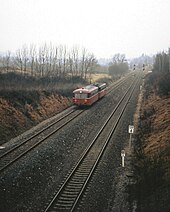
The Fichtel Mountains were accessed from all sides by a total of seven branch lines. In 1890 the Neusorg – Fichtelberg railway was put into operation, the second on August 15, 1896, the Bayreuth – Warmensteinach railway . It was the first branch line from Bayreuth .
As early as January 1888, the city magistrate had requested that the “Royal Ministry of State of the Royal House and Foreign Affairs” permit a corresponding “terrain recognition”. The following investigations by the “Royal Railway Construction Section Erlangen ” endorsed the construction of the route through the valley of the Warmen Steinach to Warmensteinach , but the desired continuation to Bischofsgrün was rejected because of the steep gradients.
The construction of the route began in spring 1895. Due to the less demanding route, it could be completed quickly, although the cramped space in the upper Steinach valley required the course of the stream to be relocated. The first timetable shows three daily train pairs.
The line left the main station to the northeast on the right side parallel to the track of the leased railway . After the construction of Hofer Strasse in the 1980s, it lost its own track and only branches off its track after about 900 meters. It then leaves the common route in a right-hand bend. In the station, the passenger trains began and ended on track 5. In the busy winter sports traffic there were through trains from Nuremberg and Bamberg , some of which were hauled by two tank locomotives and - atypical for a branch line - carried four-axle express train wagons . Goods came over the route u. a. Wood, grain and granite as well as glassware from the Fichtelgebirge to the city.
The branch lines to Hollfeld and Thurnau
As early as 1873 the government of Upper Franconia proposed a railway from Bayreuth via Plankenfels and Forchheim to Rothenburg ob der Tauber . In 1877 still intended as a main line, the Local Railway Act that came into force in 1884 forced a more cost-saving planning as a branch line to Forchheim. In 1885, the "General Directorate of the Royal Bavarian Transport Authority" was instructed to first build the route from Forchheim to Ebermannstadt . A year later, the Ministry of State promised a railway from Bayreuth to Plankenfels, but excluded the mountainous middle section between Plankenfels and Ebermannstadt. In 1887 the Hollfeld district council asked for an extension beyond Plankenfels. This project was ultimately approved, and preparatory work began in 1893. After several delays, not least due to rescheduling and legislative changes, the final approval for the entire route was not given until 1901.
On March 12, 1904, the Bayreuth – Hollfeld line was opened. In the main station, the railway was given its own butt track at the southern end of the main platform (track 1L, usable length 73 m) with an upstream rear track. From there to the Kreuzstein junction , the track of the Fichtelgebirgsbahn was also used. Initially, there were three pairs of trains on workdays.
In 1896 the "General Directorate of the Royal Bavarian Transport Authority" announced a railway line from Bayreuth to Thurnau after the Thurnau market town had requested a railway connection for the first time in 1872. Initially, the plan was to lead the route north out of the main station and to pivot west into the valley of the Red Main . However, this would have meant a crossing of the line of sight and the road to the Richard-Wagner-Festspielhaus and was therefore rejected. The chosen variant, which initially used the (Fichtelgebirgsbahn and) Hollfeld line to the Altstadt station , forced a southern circling of the city by more than 270 degrees. The railway was opened on March 26, 1909 after Thurnau had been reached from Kulmbach nine months earlier. All passenger trains were broken in Thurnau, they began and ended in Bayreuth, like the Hollfeld trains, in the main station.
The last train from Bayreuth to Thurnau ran on June 2, 1973, passenger traffic to Hollfeld ended on September 28, 1974. The tracks on the main platform in the main train station were dismantled. Freight traffic to Bayreuth Altstadt existed until 1994, in 1998 the "main line" was finally given up.
The facilities
Level crossing, tunnel and pedestrian bridge
As a result of the nationalization of the Ostbahngesellschaft on January 1, 1876, the station facilities were merged. For twelve years, the Staats-Straße from Bayreuth to Berneck had crossed the railway site at the Brandenburg Gate and at the same time separated the facilities of the leased railway from those of the Eastern Railway. From 1875 an underpass was built south of it and the level crossing was abandoned after its completion at the end of the 1870s. For pedestrians, a metal bridge, the "Eiserne Steg", was built in its place in 1885, which was torn down again in April 1940.
The reception building
The architect of the third reception building was the Munich General Directorate Seidel. The symmetrically structured building has a two-storey central block with a central projecting towards the street. The “forecourt”, the porter's lodge, the “ticket room”, the third-class waiting room, the “luggage room” and the staircase to the upper floor with the apartments for the station management and the station servant were located here.
One-storey wings are connected on both sides, ending at transverse wings with round roofs. The right wing housed the buffet, the first and second class waiting rooms and the toilets. On the left were the “bureaux” and the room for “the very highest gentlemen”, which had to be kept at all major railway stations for the king and his entourage.
The street-side facade is loosened up by round and segmented arches, the formerly beautifully designed main entrance today only has a simple, rectangular shape. On the track side, the building is kept simpler and gives the impression of a continuous, one-story building with another floor in the middle.
The platforms
In 1881 the "Einsteighalle" was replaced by the house platform on the new building and a central platform between tracks 2 and 3. Both platforms were given roofs in the middle section resting on iron pillars in the form of a flat W. Between the platforms a pedestrian tunnel was created, which was later extended to platform 3 and finally in 1996 was given access from the street on the east side. The platform roofs were - z. T. at least twice (platform 2) - replaced by successor structures.
The track system
The station extends in a north-south direction with a bend to the northeast at its north head. Two tracks reach it on both sides, which give the impression of two-track main lines, but are single-track lines running in parallel. From the north-east these are the leased railway and the Warmensteinacher branch line , from the south the eastern railway and the Fichtelgebirgsbahn . The branch line to Bayreuth old town and from there to Hollfeld and Thurnau ended 1.6 kilometers further south at the Kreuzstein junction with the track from Schnabelwaid .
The track plan from 1890 shows a through track on the house platform and two more on middle platform 2. In 1930 there was another platform 3 between tracks 3 and 4 and at its northern end the "Warmensteinacher Sackgleis" 4N for the provision of the Warmensteinach local trains starting on track 5. For the passenger trains to Hollfeld and Thurnau, there was track 1L on the south side of the house platform and in front of it the "branch line back track" 1H.
To the east of this were through tracks 6 and 8 (directional tracks to the south) and 7 and 9 (directional tracks to the north) for goods and depot traffic. Continuous tracks 10 to 14 followed, the latter in 1930 a ramp track with disinfection system. The depot with the locomotive shed was immediately south of it.
The signal boxes
Until 1908, the course was set by hand on site. In 1909 the process was centralized and four signal boxes were built. Signal box 1 was responsible for the southern entrances and exits, signal box 3 controlled those at the northern head of the station. The other two were switching stations, No. 2 for the inner and No. 4 for the northern station area.
The depot
The Bahnbetriebswerk (Bw) Bayreuth only existed as an independent service from 1930 to October 31, 1981. From then on, Bayreuth was a branch of the Hof Bw , only one Köf remained in the city for shunting tasks.
During the construction of the leased railway, a two-tier " Lokomotivremise " with heating house was built on the north side of the later reception building, which was removed again in 1863. The first locomotives belonging to the Neuenmarkt locomotive station of the Hof workshop were housed there.
The Ostbahn also built an elongated "Lokomotiv- und Wagenremise" with three tracks in 1863. It was demolished in the 1880s and rebuilt further to the east as the “Neue Wagenremise”, the three tracks of which were only accessible via a transfer table . This building was listed as a historical monument in 2018 . A twelve-meter turntable and a coal magazine were built to the southeast . The Bayreuth locomotive station of the Ostbahn was assigned to the Weiden workshop.
In 1879 the track system was partially rebuilt, the "Lokomotiv- und Wagenremise" had to give way. A four-person roundhouse was connected to the turntable and in 1905 three stalls were added. In the 1920s, the Reichsbahn replaced the turntable with a twenty-three-meter segment turntable and built a new, twelve-hour roundhouse. Other systems for the machine service were a coaling system, cleaning trenches and several water cranes distributed over the station area .
In the Bayreuth locomotive station were u. a. Machines of the B V series stationed. From outside reached z. B. P 3/5 , P 8 , P 10 , G 3/4 , G 10 , the express train locomotives C V , S 3/5 , S 3/6 and later standard locomotives of the series 01 and 50 the city.
On April 1, 1930, the Bayreuth locomotive station at the Weiden depot was upgraded to an independent depot and incorporated into the Nuremberg Railway Directorate . The operating stock initially consisted of thirteen machines: four 73.0 ( Bavarian D XII ), nine local railway locomotives of the 98.4 ( Bavarian D XI ) and 98.6 series (four Bavarian D VIII and one Palatine T 4.I ) and a shunting locomotive of the 89.6 series .
The class 73.0 locomotives were decommissioned between November 1932 and March 1934, the 98.4 were relocated. Instead, the Bavarian 98.10 and standard class 64 locomotives came to the Bayreuth locomotive shed, and during the war two BR 57.10 , six BR 78 and one BR 86 , BR 91 and BR 94.5 each .
Traffic
Tourist traffic
After the construction of the railway in the Bayreuth area was completed with the opening of the line to Thurnau , the main station was in the center of a balanced railway star that shone evenly in six directions. Although local traffic predominated (32 or 33 trains per day and direction in 1914), the timetable of May 1, 1899, for example, offered an express train connection from Berlin via Leipzig and Nuremberg to Stuttgart . At the beginning of the 20th century, further long-distance trains connected the city and a. with Dresden , Metz and Breslau . The First World War brought the last pair of express trains to an end in 1917.
From the summer of 1920, long-distance connections revived, sometimes with other destinations. A cross-country skier was the D 325/326 from Geneva via Bayreuth to Warsaw and back. In the summer of 1939, 24 national and international express and express trains ran to the main station . There were also 40 local trains every working day . On July 3, 1944, only two long-distance trains and about 25 trains ran in local traffic. In a bombing raid by the United States Army Air Forces on April 5, 1945, the station was badly damaged and no train journeys were possible.
The special trains and coaches to the local Richard Wagner Festival were a Bayreuth specialty . In the summer of 1902 a first pair of trains ran from Paris via Bayreuth to Eger and back. In 1904 through cars u. a. from Berlin, Karlsbad and Saarbrücken occupied. This special service was inactive between 1915 and 1923, until 1939 only festival trains from Nuremberg and Eger operated.
Other special trains were the “demand winter sports trains” from Nuremberg to Warmensteinach and back. They operated for the first time on February 9, 1908, with the note “The dispatch is announced each time by notice in the stations and in the daily newspapers , via Bayreuth to the branch line into the Fichtel Mountains .
In 1910 394,000 tickets were sold at the main station, an average of 1080 per day. Interrupted by the effects of the Great Depression, this figure rose from 1929 (800 tickets a day) to 2020 tickets a day by 1941.
Freight transport
Express goods , general cargo and wagon loads were handled in the freight yard . While in express freight transport (example daily average in 1928: 2.3 t in receipt, 1.5 t in dispatch) and wagon loads (example daily average in 1932: 322 t = 21 goods wagons in reception, 39 t = 3 goods wagons in dispatch), reception and dispatch predominantly, it was the other way around for general cargo (example daily average in 1932: 31.2 t in receipt, 36.5 t in dispatch).
In the spring of 1994, Deutsche Bahn decided to give up general cargo handling in Bayreuth and relocate it to Bamberg .
Transporting prisoners
During the National Socialist era , political prisoners and Jews were deported from Bayreuth Central Station. On February 17, 1945, 221 political prisoners arrived in four cattle wagons - including the later President of the Bundestag Eugen Gerstenmaier - who were to be tried in the People's Court , which had been relocated from Berlin to Bayreuth .
Between February 27 and March 1, 1945, five women, including a seventeen-year-old girl, died in locked freight cars. Her train, which had brought her from the Ravensbrück concentration camp , stayed in Bayreuth for several days.
Post-war period and German Federal Railroad


In the last days of the war the station was exposed to bomb attacks. The freight hall and the depot were badly damaged, locomotives and wagons destroyed, the track field was churned up, the platform roofs covered. From April 5, 1945, the train service stopped.
On June 5, 1945 the lines to Kirchenlaibach and Schnabelwaid were put back into operation, on June 8 to Neuenmarkt-Wirsberg , on June 11 to Bayreuth Altstadt and on June 24 to Warmensteinach. At first there was no regular train service. From September 15, 1945, a working pair of trains ran from Warmensteinach, initially to St. Georgen station and back. The timetable of April 10, 1946 lists four daily train pairs to Neuenmarkt-Wirsberg and Schnabelwaid and one to Hollfeld.
The dispatcher was relocated from the ruins of the second station building to signal box 1. The former was replaced by a wooden barrack that housed the “Military Ticket Office” and was replaced in 1950 by a brick structure. The supervisory officer, the railway police and the station mission also had to move to wooden shacks on the platforms. The destroyed wings of the depot and the goods handling area were rebuilt, the roofs of the platforms were renewed in 1951.
As a result of the inner-German border , Bayreuth was in a peripheral location, which had an impact on long-distance traffic. From 1950 onwards there were mainly express trains, including cross-country skiers from Bayreuth to Munich, Stuttgart and Kaiserslautern . Of the few express trains, the routes Nuremberg - Prague (from 1964), Strasbourg - Bayreuth (from 1970) and Chiasso - Bayreuth (from 1987) are worth mentioning.
On the occasion of the Richard Wagner Festival in the post-war period there were almost only through coach connections that can be found for the first time in the 1951/52 annual timetable. They led u. a. to Amsterdam , Vienna , Hamburg and Zurich , in 1953 Paris and Bologna were reached. The special trains to Nuremberg waited for the end of the respective performance in the Festspielhaus . Special trains ran for the last time in the summer of 1966; the use of the festival coaches ended in the summer of 1981.
From the winter of 1951/52 to the winter of 1963/64, winter sports trains ran again from Bayreuth and Nuremberg to Warmensteinach. Staff and vehicles were on standby for this on Sundays. At major winter sports events also reversed a special train from Bamberg and back of the main station head made .
The Thurnau passenger trains on the Bayreuth Altstadt – Kulmbach railway always began and ended at the main station. All traffic on this route ceased on June 3, 1973, and passenger traffic to Hollfeld on September 29, 1974 .
In December 1966, the barriers to access to the platforms were removed and there were no platform conductors. Around 1980 the "Thurnauer Gleisstutzen" (track 1L) was demolished, on December 8, 1981, a pushbutton interlocking was put into operation at the location of the old interlocking 1. In the following spring, the no longer needed signal boxes 2 and 3 were removed after the former had been replaced by a modern, small switch box.
The change in traction in the Bayreuth depot was preceded by a standardization of the steam locomotive park. In addition to the class 64 machines that had been stationed there since the 1930s, class 98.11 locomotives (converted Bavarian GtL 4/4 ) supplemented the stock from 1949 . They ran in passenger and freight trains on the three branch lines.
In May 1953, the first VT 95 rail buses appeared , with which the timetable of the Bayreuth local railways could be considerably compressed. 1955 came for shunting diesel locomotive of the series V 60 and 1956 V 45 to do so. Both were also used in passenger train service on the Falls – Gefrees railway line . The first V 100 moved into the local depot in 1958, followed by a Köf III in 1963 . VT 98 series rail buses lasted until the late 1980s.
In 1958 the Bayreuth depot had five, and in 1968 thirteen rail buses of the VT 95 series. In 1978 they were no longer listed. The class VT 98 railcars used in Bayreuth belonged to the Hof depot.
The diesel locomotive series V 80 and V 200 came to the city from outside .
In the last few years of the Federal Railways, in addition to locomotive-hauled trains, there were mainly class 614 and 628 railcars . In the summer of 1992, the station saw the first scheduled operations of the 610 series . The “ Pendolino ” tilting trains , specially procured for traffic in Upper Franconia , ran every hour between Bayreuth and Nuremberg from May 31st, with the route in both directions being covered in less than an hour for the first time with a journey time of 59 minutes.
Deutsche Bahn AG and private railways
vehicles
All railway lines around Bayreuth are not electrified. Up to 2012, diesel multiple units of the 610 series were mainly used as Regional Express , since then only the 612 series has been running . The agilis local trains consist of Stadler Regio-Shuttle RS1 railcars (650 series).
Class 605 multiple units were used as long-distance trains from 2001 to 2003 . These trains were stopped because of problems and first by Intercity trains pulled by diesel locomotives of the series 234 , replaced.
Since December 2006 there has been no long-distance traffic in Bayreuth. Instead, the then newly created Interregio-Express train type was introduced. It connected Nuremberg to Dresden via Bayreuth until December 2013 as the Franken-Sachsen-Express, since then a regional express has been running from Nuremberg to Hof, where there is a change to Dresden.
traffic
| Train type | Train run | Clock frequency |
|---|---|---|
| RE | Nürnberg Hbf - Bayreuth Hbf - Münchberg - Hof | 120 min |
| RE | Nürnberg Hbf - Hersbruck (r Pegnitz) - Pegnitz - Bayreuth Hbf | 30 min |
| RE | Nuremberg main station - Hersbruck (r Pegnitz) - Pegnitz - Bayreuth main station - Lichtenfels - Bamberg | 120 min |
| RE | Lichtenfels - Neuenmarkt-Wirsberg - Bayreuth Hbf | 120 min |
| ag | Coburg - Lichtenfels - Neuenmarkt-Wirsberg - Bayreuth Hbf | 60 min |
| ag | Bad Steben - Hof - Oberkotzau - Marktredwitz - Kirchenlaibach - Bayreuth Hbf | 60 min |
| ag | Weiden (Oberpf) - Kirchenlaibach - Bayreuth Hbf - Weidenberg | 60 min |
See also
gallery
South head of the station with diesel locomotives of the 232 series (left) and 218 , 2003
On the left the “water house” of the main station - the red water tower belonged to the mechanical cotton spinning mill
literature
- Robert Zintl: Bayreuth and the railroad . Gondrom, Bindlach 1992, ISBN 3-8112-0780-6 .
- The Bayreuth Bw , loose-leaf collection from GeraNova Verlag Munich
Web links
- Bayreuth Hbf atzielbahnhof.de
- Transport, public transport. In: bayreuth.de. City of Bayreuth, accessed on June 21, 2017 .
- Tracks in service facilities (NBY) , DB Netz AG (PDF) Track plan of Deutsche Bahn
- Location and course of the railway system as well as some signals on the OpenRailwayMap
Individual evidence
- ^ Robert Zintl: Bayreuth and the railway . Gondrom, Bindlach 1992, ISBN 3-8112-0780-6 , p. 19 .
- ^ Robert Zintl: Bayreuth and the Railway, p. 21.
- ^ Robert Zintl: Bayreuth and the Railway, p. 43.
- ^ Manfred Bräunlein: Die Ostbahnen, S, 148.
- ^ Robert Zintl: Bayreuth and the Railway, p. 44.
- ^ Kurt Herterich: Im eastern Bayreuth, p. 142.
- ^ Robert Zintl: Bayreuth and the Railway, p. 45.
- ^ Robert Zintl: Bayreuth and the Railway, p. 47.
- ↑ Manfred Bräunlein: Die Ostbahnen, p. 146.
- ↑ Bernhard Ücker: The Bavarian Railway 1835-1920 , p. 145.
- ^ W. Bronnenmeyer: Richard Wagner. Citizens in Bayreuth . Ellwanger, Bayreuth 1983, p. 112 ff .
- ^ Robert Zintl: Bayreuth and the Railway , p. 107.
- ^ Robert Zintl: Bayreuth and the Railway, p. 64.
- ^ Siegfried Bufe: Railway in Upper Franconia, p. 224.
- ^ Robert Zintl: Bayreuth and the Railway, p. 91.
- ^ Robert Zintl: Das Thurnauer Bockela, p. 103.
- ↑ Kurt Herterich: From Bayreuth Castle Tower to Festival Hill, p. 141.
- ↑ Bernd Mayer: Bayreuth in the twentieth century . Nordbayerischer Kurier, Bayreuth 1999, p. 86 .
- ^ The Bw Bayreuth , loose-leaf collection of the GeraNova Verlag Munich, p. 27.
- ^ Robert Zintl: Bayreuth and the Railway , p. 116.
- ↑ Lok-Remise is a memorial in: Nordbayerischer Kurier from November 22, 2018, p. 13.
- ^ Robert Zintl: Bayreuth and the Railway, p. 136.
- ↑ The Bw Bayreuth , loose-leaf collection of GeraNova Verlag Munich, p. 14.
- ^ Robert Zintl: Bayreuth and the Railway, p. 143.
- ↑ 25 years ago in: Nordbayerischer Kurier from 11./12. May 2019, p. 10.
- ^ Norbert Aas : From the illegality in Berlin to the opposition in Bayreuth . Publishing house by H.-J. Hagen's Antiquariatsbuchhandlung, Bayreuth 1988, ISBN 978-3-926392-03-9 , pp. 19 .
- ↑ Helmut Paulus: The gruesome plans of the Nazi justice . In: Heimatkurier - the historical magazine of the North Bavarian Courier , issue 2/2005, pp. 8 and 9.
- ^ Commemoration on hold in: Nordbayerischer Kurier of December 13, 2016, p. 9.
- ↑ Course book summer 1981 of the Deutsche Bundesbahn, p. E 171.
- ^ Robert Fritzsch: Railways in the Pegnitztal . EK-Verlag, Freiburg 2002, ISBN 3-88255-454-1 , p. 41 .
- ↑ 50 years ago in: Nordbayerischer Kurier of December 7, 2016, p. 12.
- ^ Robert Zintl: Bayreuth and the Railway, p. 157.
- ^ Robert Zintl: Bayreuth and the Railway, p. 162.
- ↑ Jörg Hajt: Farewell to the rail bus, p. 47.
- ^ Robert Fritzsch: Railways in the Pegnitztal , p. 93.
- ^ Robert Zintl: Bayreuth and the Railway , p. 163.
- ↑ Stephan-H. Fuchs: Bayreuth Chronicle 1992 . 1st edition. Gondrom, Bindlach 1992, ISBN 3-8112-0793-8 , p. 58 f .
- ^ Robert Zintl: Bayreuth and the railway , p. 166 f.
- ↑ Connection secured until 2014 ( memento of June 10, 2012 in the Internet Archive ), accessed on January 4, 2013.

